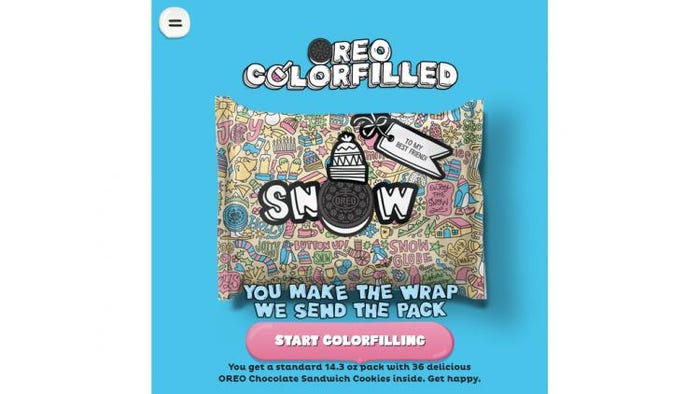4 snacking trends and their packaging implications, from Mondelez innovator Gil Horsky
While the sit-down family dinner isn’t dead, it seems to be the exception rather than the rule. Today, consumers are more likely to snack throughout the day, even when socializing over the weekend.
What does this mean for packaging development and design? Gil Horsky, global innovation head from chocolate, biscuit, candy and gum brands powerhouse Mondelēz Intl., pinpoints four snacking trends that packaging designers can leverage to create product/package combinations that win consumers over. He is presenting these at the Food Vision conference (Mar. 1-3; London, UK) on Thurs., Mar. 2.
1. Mission Nutrition: From the addition of functional ingredients to catering for health conditions and intolerances, snack companies must meet consumers’ wellness agenda.
2. Pure Pleasure: From chocolate inhalers to lollipop cakes, clever producers are turning “snacks” into “experiences” that enliven and enrich.
3. Social Snacks: Consumers don’t want to snack alone. Sharing and personalization can turn snacking into a social activity.
4. Instant Everywhere: Buy-on-the-go lifestyles demand new retail and vending formats that make snack buying instant, affordable and fun.
Packaging Digest learns more from Gil Horsky about the future of snacking and packaging’s starring role.

Gil Horsky
You say that consumers expect a lot from their snacks today. Why is that? And how can/should food companies leverage packaging to deliver on their high expectations?
Horsky: One of the most significant changes that occurred in how people consume food is the way that snacks are encroaching upon the traditional meal-times. Younger consumers are swapping the more traditional three daily meals with five or six substantial snacks per day. It is amazing to think that a few decades ago the packaged snacking category hardly existed, while today it is one of the fastest growing food segments, with the number of daily snacking occasions constantly growing. With this increased role snacks play in people’s lives, their expectations of these snacks are on the raise.
Packaging is the dark horse of the marketing world. Compared with other marketing levers, it doesn’t receive enough attention, and its impact is still underestimated by many food and snacking manufacturers. However, it has been shown by Nielsen that optimized packs generate an average 5.5% increase in sales revenue, and can drive trial, build brand equity and serve as a key medium for communicating an innovation’s “job to be done.”
One mind-shift still required by many manufacturers, is the realization that they must place packaging exploration and development at the forefront of their innovation process. Some manufacturers focus only on the edible product and leave the packaging to the end of the process, as an after-thought. That approach has been proven not to work—to exceed consumer expectations of new snack offerings, packaging requires the same attention by marketers and product developers as the actual edible product receives.
Your “Mission Nutrition” point centers on consumers’ wellness agenda. Packaging graphics and labeling play an important role. What should packaging designers be focusing on in this regard?
Horsky: Allergies, intolerances and the rapid increase in conditions such as obesity and diabetes are shifting the way people think about snacking. Being healthy is becoming increasingly aspirational as consumers become more conscious about the food choices they make.
This also means consumers are expecting food companies to be part of the solution, and not the problem.
Developing the right brand positioning and corresponding packaging design plays a key role in communicating effectively to consumers those health-benefits. I am a big believer that—with regards to pack design and health benefits—less is more. Therefore, it is critical to have a clean design with a single-minded benefit, making it clear on pack to the consumer what is the one “job” this product will help them solve for.
A great example is Belvita Breakfast Biscuits (see photo above), a product that is single minded in its positioning and pack design that communicates clearly the benefit it provides of “4 hours of nutritious steady energy” to continuously fuel the consumer‘s body through the morning.
You talk about how snacks need to be more than just food; they need to be a “Pure Pleasure” experience. Does most packaging today add or distract from that? How can packaging enhance the encounter?
Horsky: With the growth of post-materialist values, pursuing happiness and expressing status is about more than wealth. People seek experiences that truly enable them to cherish the moment, which also explains why Mindfullness has become such a significant trend.
This transcends also to snacks—for example, from consumer research around the globe, we know that snacking on chocolate is often experienced as an intense moment of relaxation, momentarily releasing consumers from work and life pressures, offering the possibility of escapism and self-expression.
This means that snack manufacturers need to up their game and offer experiences to consumers and not just promote food intake. To do this right, marketers and designers need to maximize the role that the pack structure and pack design can play in enhancing those “pure pleasure” experiences.
For example, the recently launched Green & Black’s chocolate brand in the U.S. comes in beautiful packs that present a library of expertly crafted chocolates bars that enhance the overall consumption experience.

Le Whif from France, is another example of a unique pack structure that in essence creates a new way to consume chocolate by “breathing” it through your mouth rather than the traditional way of chocolate consumption via biting and chewing. The product is of course niche, but the execution is very disruptive in my opinion.

One of the trends you’ve identified is “Social Snacks.” With snacking often replacing meals, consumers want to make it a more social activity, which involves sharing. Again, how can packaging help facilitate this?
Horsky: As many people feel isolated and stressed, they look for more ways to connect up with each other, especially with new easy social networking tools. As snacking becomes an integral part of consumers’ lifestyles, sharing these becomes another important way to create and augment social experiences. Even when snacking solo, consumers are looking for ways to avoid feeling like it is an isolating indulgence.
The fast technological evolution of digital printing and 3D printing have opened up new possibilities in terms of product and packaging personalization and sharing. A great example is Oreo’s customized Colorfilled packs, that consumers personalized online and either gifted or shared with their friends and family.

Portability continues to be a key consumer convenience, especially for snacking, which is often done while people are on the go. Explain how this “Instant Anywhere” trend is driving more innovation in packaging formats for retail and vending.
Horsky: Time is an increasingly precious resource and our multitasking lifestyles are propelling a need for short-cut solutions, as consumers expect products to simplify their lives. The hectic pace of modern life has fuelled the evolution of snacking and other on-the-go products. In fact, according to Mintel, the number of global food and drink launches with on-the-go claims increased by 54% in the past year.
New pack and product formats enable consumers to snack on-the-go with product categories they have never been able to do so before. Go Cubes is a great example of a product that offers chewable coffee cubes that provide the same caffeine as one cup of coffee. Another one is Paper Boat, a highly successful new brand in India that offers traditional Indian drink recipes in grab-and-go packaging with nostalgic graphics and illustrations.


I believe that moving forward some manufacturers will start leveraging their packaging to clearly communicate the selling point of the “time saved” by that specific food or drink product.
How can one snack, one package deliver on all these four points?
Horsky: The good news is that one snack doesn’t need to deliver on all of these. The snacking segment is large enough with multiple consumer needs and occasions, that single-snack offerings should be focused on solving specific consumer needs in specific occasions, instead of trying to do too many things in one offering.
********************************************************************************
Learn what it takes to innovate in the packaging space at the new Advanced Design & Manufacturing Cleveland event (Mar. 29-30; Cleveland, OH). Register today!
About the Author(s)
You May Also Like




